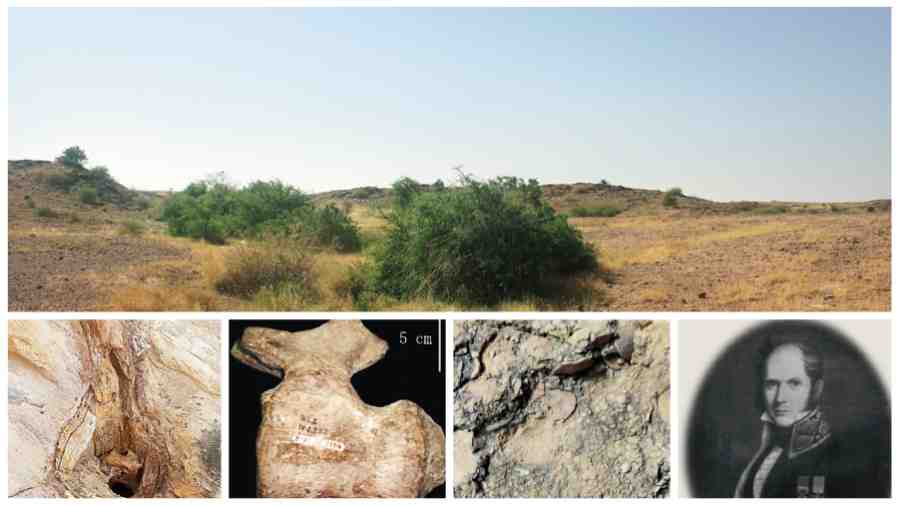Major General William Henry Sleeman was a B r i t i s h soldier and administrator in India, best known for the suppression of “thugees” or organised gangs of robbers and murderers between 1830 and 1856. But very few people know that Sleeman also happens to be the first to discover dinosaur fossils in Asia while he was serving as captain in the Narmada Valley in 1828.
During his stint at Jabalpur in what is now Madhya Pradesh, Sleeman noticed some basaltic rock formations “raised above the waters” at the Bara Simla Hill. He wrote about them in his memoirs Rambles and Recollections of an Indian Official.
Sleeman had chanced upon fragments of dinosaur fossils, including a vertebra of a gigantic dinosaur, identified as Titanosaurus indicus five decades later. The creature (weighing about 13 tonnes and 32 feet in length) is believed to have roamed central India 70 million years ago.
When Sleeman found the first dinosaur fossil in India, he had neither proper training nor exposure to fossil hunting, or collection of fossils for scientific study, hobby or profit. Fossil collecting, as practised by amateurs, is the predecessor of modern palaeontology, perceived to be a glamorous profession after Hollywood movies like Indiana Jones, Jurassic Park and Lara Croft were released.
As an amateur fossil hunter, for the past few years, I traced various zones of central India that were once a haven for dinosaurs, comparable to the Badlands in South Dakota in the US or Jurassic Coast in southern England. I found 50-croreyear-old specimens of Earth’s oldest living forms, such as stromatolites or layers of primordial micro-organisms. In 2021, Dickinsonia, one of the world’s rarest fossils, was discovered by two Geological Survey of India (GSI) scientists in the rock shelters of Bhimbetka in Madhya Pradesh.
Sleeman, born in Stratton in England in 1788, joined as a cadet in the East India Company’s Bengal Army when he was 20. A curious observer, he was surprised to find “ripple marks” on certain sandstones in many areas of central India and had unearthed some “petrified trees”.
Sleeman got involved in fossil hunting when he stumbled upon the dinosaur fossil at the British Army’s gun carriage workshop in Jabalpur. He sent the two fossil bones to the Jabalpurbased civil surgeon G.G. Spilsbury, who too had collected a bone fragment from the Narmada bed. Spilsbury dispatched all three bone fragments to James Prinsep in 1832. Prinsep, an assay master at the Calcutta Mint, more famous as a scholar, orientalist and antiquarian, had built a vast network of fossil hunters with officers of the East India Army posted in remote corners.
Prinsep surmised those fragments had links to ancient remains found in the Siwalik region of the Himalayas. He realised that there was immense scope of exploring the subject. He quickly put out a notice that volunteers were required for finding fossils in the Narmada Valley. Since British officers were neither trained nor exposed to such activities, they were briefed to collect rocks with unusual shapes or have some local myths or legends attached to them. The officials were asked to document the myths associated with the samples. My recent Bengali book Otho Fossil Ubacho (Legend behind fossils) discusses many such myths and my personal accounts of fossil hunting.
It was not until 1862 — 30 years after Prinsep received Sleeman’s specimens — that the fossils were shown to Sir Thomas Oldham, the first director of GSI. Then surgeon-botanist Hugh Falconer, superintendent of the Calcutta Botanical Garden in Shibpur, Howrah, identified two bones as caudal vertebrae or tail bones of some giant reptile.
The arrival on March 4, 1851, of Oldham, professor of geology at Trinity College Dublin and chief of the Irish Geological Survey, marks the beginning of the GSI which later became a prominent geo-scientific organisation. Palaeontology became crucial for revealing geologic history and defining evolutionary patterns of life that survived through the ages. Oldham, a seasoned geologist, having realised the importance of Sleeman’s discovery, took plaster casts of the fossil and had them sent to the Natural History Museum in London in 1862. Richard Lydekker, a geologist at the Natural History Museum of London, studied the plaster cast in 1877 and concluded Sleeman had serendipitously discovered the remains of the dinosaur Titanosaurus indicus.
But the original specimen of the fossil bones found by Sleeman went missing. They were rediscovered in a cupboard in the GSI museum in Calcutta in 2013, when researchers along with some palaeontologists from the University of Michigan, US, were studying old collections. They reported the rediscovery of Sleeman’s fossil bones in Current Science.
The Indian dinosaur species was found just four years after the first dinosaur discovery globally. In the meantime, museum specimens as well as the sites where the fossil bones were discovered have been utterly neglected. Most sites rich in fossils don’t have any legal protection and local people often treat field workers with hostility and suspicion. Poaching of fossils is rampant. Also, people take fossil hunters as treasure hunters and it is very difficult to get the common folk into the efforts of preservation. Many fossil-enriched areas, especially limestone belts, are being leased to big corporate houses for quarrying and it becomes difficult to get access to these spots.
In this context, M.P. Singh, president of the Palaeontological Society of India, says, “Amateur fossil hunters serve like a bridge between the common people and palaeontologists.”
Sleeman is like a role model for amateurs like us. However, fossil collectors must have basic knowledge of evolution and the geological time scale to understand the importance of their finds. A blend of knowledge and passion is needed to make oneself a true flag bearer of Sleeman.
Bhattacharya is an amateur fossil hunter and a director of a corporate group in New Delhi










